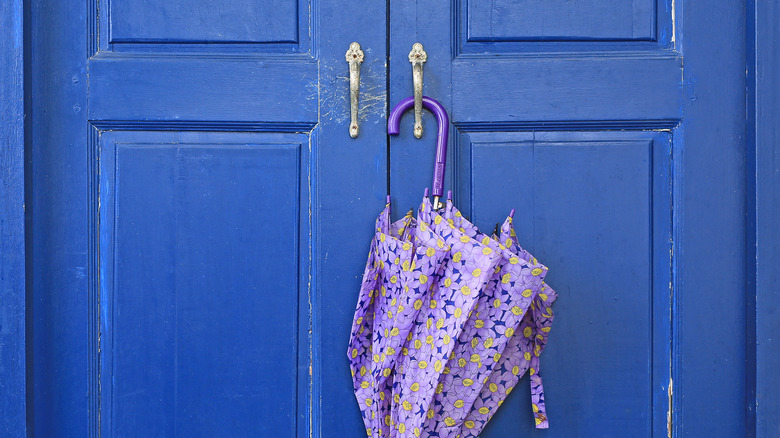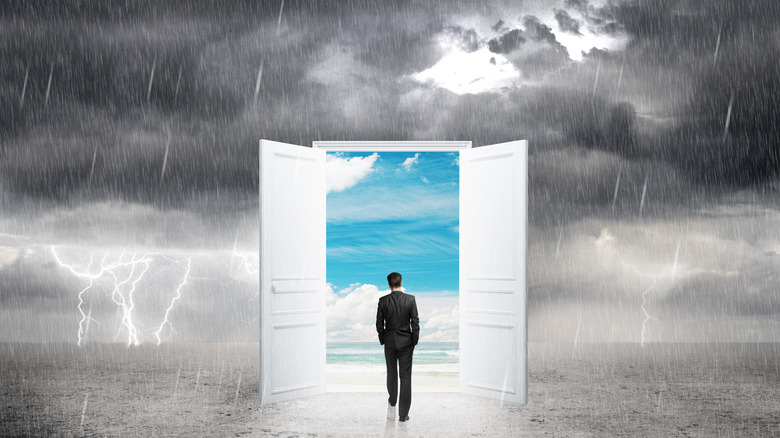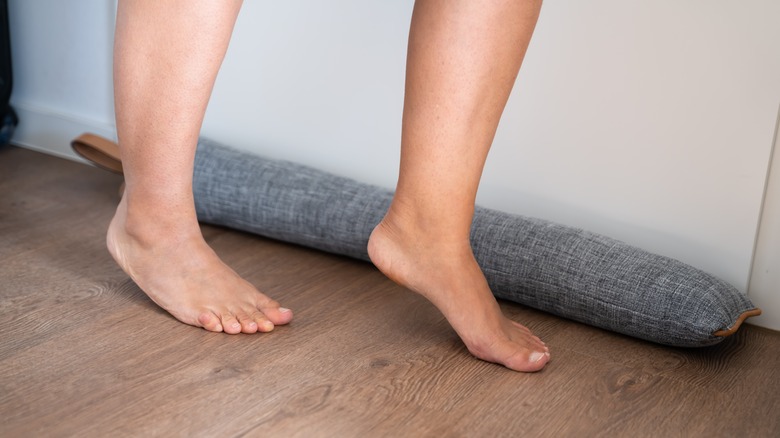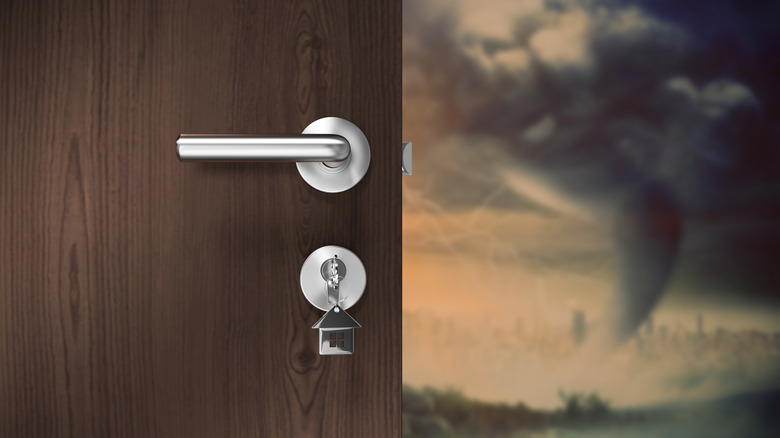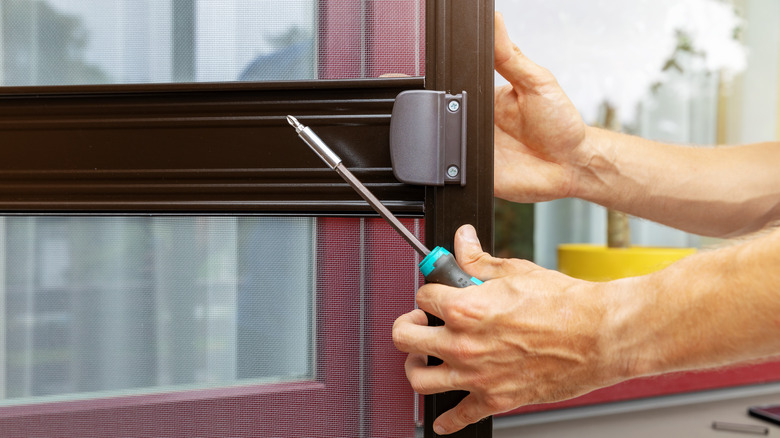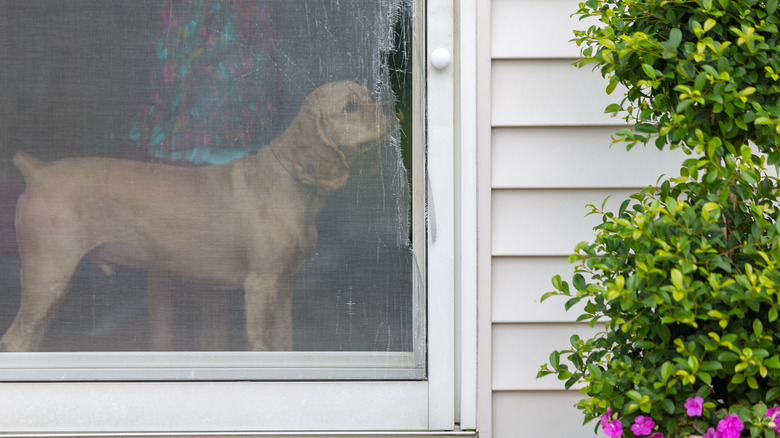5 Reasons Why You Should Install A Storm Door
In some ways, installing a storm door is akin to putting suspenders on when you're already wearing a belt — storm doors are placed in front of existing doors, in principle to act as protection against cold, wet and blustery conditions, explains Quality Overhead Door. A door is already supposed to keep the weather at bay — so what is the point in adding a door on top of your door?
According to Home Reference, installing a storm door over damaged or dated doors is likely to bring a lot of benefits as they tend to be bad insulation, either because of wear and tear or due to being made from less-than-ideal materials in the first place. But if your door is more up-to-date and high-end then the minor benefits of a storm door might well be outweighed by the extra inconvenience.
However, in certain situations installing a storm door is just about the smartest thing you can do for a doorway. In this article, we will explore five situations in which storm doors can dramatically improve your home's entrance. If you are looking for an upgrade in any of these areas, a storm door might be a great addition to your house.
Storm doors for weatherproofing
The most obvious context in which a storm door is going to be a worthwhile investment is where the weather conditions suit it best. According to Save On Energy, storm doors are at their most effective in climates with frequent storms, summers that blaze, and winters that bite. A properly fitted storm door will keep heat in and draughts out during the winter months, protect the door itself from weather damage, and help keep the house cool in the summer.
Storm doors are especially useful for protecting old doors. According to Porch, the average cost to buy and install a storm door in the U.S. is $527. The main way in which homeowners recoup this investment is through energy savings. Generally speaking, the older the door, the more vulnerable it is to penetration from water (rain, ice, or snow) or air, which is not only bad for home insulation but potentially reduces the lifetime of the door itself, per TruBuild Construction.
There are certain situations, though in which storm doors amplify, rather than reduce, the negative impacts of weather. According to Energy.gov, if the door you want to protect sits in direct sunlight, then the glass can act as a mini greenhouse and cause a lot of damage by exposing the door to massive heat fluctuations.
Storm doors for draughts
Storm doors reduce energy loss in the winter in two main ways, explains The Washington Post — by adding an extra barrier the new door will help plug any leaks in or around the existing door, and also the air pocket formed between the old door and the storm door acts as extra insulation in a similar way to double glazed windows.
According to the State of Illinois, doors account for only 11% of heat loss in a modern house — but if they are old or in poor condition then this number can jump dramatically. This fits with the rule of thumb that the better and more modern your door, the less significant the savings from installing a storm door.
The National Energy Assistance Directors Association states that energy costs have increased dramatically since 2020. On average it costs $314 more to heat a house in 2022 than it did in 2020, and for households that rely on oil to heat their home, that increase is an eye-watering $903. Therefore, even minor savings can make a difference, and as the benefits of storm doors aren't limited to just winter efficiency, it's now easier than ever to justify installing one.
Storm doors for security
Though the primary purpose of storm doors is securing your home against the elements, they have some incidental benefits, one of which is making your home more difficult to enter for burglars.
In the simplest terms, a storm door doubles the number of doors that a potential intruder needs to break through in order to get into your home. As eSafe Magazine pointed out, the strength required to ensure an external storm doorframe will stand up to strong storms can be enough to deter any attempt to gain entry by force. Wisegeek refers to these super-sturdy storm doors as security storm doors, characterized by thicker, heavier materials, laminated security glass, and internal deadbolts that won't be easily kicked in.
According to Consumer's Advocate, nine out of ten burglars will move on from a house that they identify as having a security system — since they are very likely to find an unprotected house nearby. Per the same article, 33% of home robberies occurred through unlawful rather than forced entry — meaning a third of home burglars gain entry through doors or windows that are unlocked. A storm door won't lead to improved security if it isn't locked, however, as long as they are secured properly, storm doors can act as an effective deterrent.
Storm doors for summer days
During the warmer summer months, insulation takes on a different meaning, as keeping cool air in the house becomes the priority. If your home climate is dependent on air conditioning, then the same rules hold true in summer as in winter. Moreover, many storm doors have interchangeable panels, notes Pella. When the weather changes, the panel can be changed from glass to screens as needed. This means that in the winter, warm air can be kept inside, but in summer the house can be opened up to ventilate naturally while the screens keep bugs, dust, and pests out.
Opening one door isn't enough to ventilate properly — the air needs somewhere to go. This means there needs to be another adequate opening on the opposite side of the house for the space to be cooled. This will create a cooling flow of air thanks to natural pressure and temperature gradients, according to ArchDaily. By making the fullest use of your storm door in the summer months as well as during periods of bad weather, you can stay cool, save energy, and also spend less maintaining or replacing your existing climate control tech.
Storm Doors for pet lovers
The strongest argument against installing a storm door is the inconvenience of unlocking and opening another door all of the time, explains Appliance Analysts. It seems like simple math — twice as many doors, twice as much opening. However, there is one wildcard guaranteed to make a storm door drastically more or less convenient to live with — pets.
Most practical and financial deliberations around storm doors concern controlling the flow of air and energy in and out of your house. However, if you're responsible for opening and closing the door to let a pet in or out, this can be a significant amount of effort you're adding to your day. This effort can be reduced by buying a storm door with a pet door pre-installed, or by undertaking a project to add a pet door to a pre-existing storm door — although adding a pet door after purchase runs the risk of voiding the warranty, warns Larson.
A pet-friendly storm door with ventilation screens means a summer of freedom and mental stimulation for your furry friend, reducing bathroom accidents and other bad behavior related to being stuck inside, notes Top Dog Tips. In winter, pet doors can help keep the insulative properties of your storm door — the magnetic Endura Flap stays shut in winds up to 50mph. It's not hard to see how opening the internal door to let your pet exit via the pet door releases significantly less heat than opening the entire thing.
